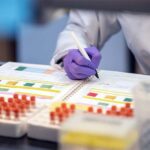Made-to-order therapies get a boost with new FDA guidelines

Ed. note: Mila passed away in February, 2021, at age 10. The Mila’s Miracle Foundation continues to work to pave a pathway for personalized treatments.
Science-based treatments for rare genetic diseases have burgeoned in the past decade. That includes diseases so rare they affect just a handful of patients — or in some cases, just one.
In 2017, researchers at Boston Children’s Hospital made history, creating a customized drug for a girl named Mila with Batten disease. The drug blocked the effects of her one-of-a-kind genetic mutation just nine months after finding it. In 2018, Dr. Timothy Yu, who led the drug’s development, got permission from the U.S. Food and Drug Administration (FDA) to try it. Weeks later, Mila received her first dose of milasen, launching the first-ever clinical trial of a new drug created to order for a single patient.
Fast-track drug development
Mila’s landmark case has provided a blueprint for other fast-track efforts, often involving families racing against the clock to treat their child’s life-threatening condition. Mila’s mother, Julia Vitarello, is working with Dr. Yu to turn the learnings from developing milasen into a way of making individualized treatments accessible across all rare diseases. Boston Children’s has now launched “n of 1” clinical trials for two other diseases, ataxia-telangiectasia and KCNT1 epileptic encephalopathy. Trials are in the pipeline for several other rare, life-threatening childhood conditions as well.
“Academic medical centers are leading the way in creating customized treatments, since there are few commercial incentives to develop drugs for just a handful of patients,” says Dr. Yu. “There’s a huge unmet need. Only five percent of people with a rare disease have an FDA-approved treatment, and 30 percent of affected children will die before age 5.”
Many of the new treatments belong to a class known as antisense oligonucleotides or ASOs. These are short segments of artificial genetic code that mirror a specific piece of the patient’s DNA. ASOs can turn on a gene, silence a gene, or boost a “backup” gene — whatever is needed. As a class, ASOs have excellent safety profiles, and they are relatively easy to design and manufacture. Different pieces of code can literally be swapped in, allowing ASOs to be customized to a patient’s specific mutation.
Working with the FDA on ‘n of 1’ treatments
Recognizing the potential of custom ASOs for patients with rare diseases — and the challenges of developing treatments for one or a few patients — the FDA has been working with Dr. Yu and others to develop standards. Last week, the FDA released its initial procedural guidance for physicians and scientists. The guidance explains how to navigate regulatory requirements in seeking to test custom ASOs in humans. Further installments are expected to follow.
“Taking advantage of customized ASOs requires new ways of thinking about drug manufacture, validation, trial design, and approval,” says Dr. Yu.
Back at Boston Children’s, Dr. Yu is partnering with multiple hospital departments to create a systematic process so that ultra-personalized rare disease treatments can be developed quickly when the need arises.
“We are way out in front in creating a hospital process and structure for reviewing and monitoring these therapies,” says Dr. David Williams, chief scientific officer at Boston Children’s. “We have set up robust processes to ensure scientific rigor and patient safety, and to consider ethical questions. Other institutions are now emulating our example.”
A path forward
Much of this is still uncharted territory. As the FDA guidance points out, families need to know up front how the effectiveness of a custom treatment will be measured, and the likelihood of effectiveness when started at different points in the child’s disease. Finally, they should recognize the possibility that an investigational drug may fail or cause unforeseen side effects when put to the test.
“The release of this guidance from the FDA is a first step and a very welcome one,” says Dr. Yu. “It speaks to the promise of precise, genetically targeted medicines for rare disease patients with currently unmet needs, and acknowledges the need for thoughtful frameworks to deliver on that promise. We’re grateful to be contributing to this important conversation.”
Learn more about the Precision Medicine Service.
Related Posts :
-

New research sheds light on the genetic roots of amblyopia
For decades, amblyopia has been considered a disorder primarily caused by abnormal visual experiences early in life. But new research ...
-

Parsing the promise of inosine for neurogenic bladder
Spinal cord damage — whether from traumatic injury or conditions such as spina bifida — can have a profound impact on bladder ...
-

“Princess June” reigns supreme over Rasmussen syndrome
What do you call a “girly” 5-year-old who adores dolls and frilly nightgowns? If you’re one of June Pelletier’...
-

Thanks to Carter and his family, people are talking about spastic paraplegia
Nine-year-old Carter may be the most devoted — and popular — sports fan in his Connecticut town. “He loves all sports,” ...





